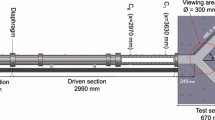Abstract
During measurement of the plume rise from the 381-m International Nickel Company stack (in the Sudbury area), it was observed that on some occasions the plume bifurcated. The bifurcation lasted for periods ranging from a few seconds to tens of minutes. During this time, the plume behaved like two separate plumes, each attached to the chimney, with a relatively clear region between the two plumes. The two branches travelled downwind at either the same or different heights, depending on the ambient meteorological conditions. Vertical wind direction shear tended to diffuse the two branches at different rates.
In an attempt to explain the initiation and the mechanism of bifurcation, field observations are presented and analyzed.
Similar content being viewed by others
References
Bosanquet, C. H.: 1957, ‘The Rise of Hot Waste Gas Plumes’, J. Inst. Fuel. 30, 322–328.
Briggs, G. A.: 1969, ‘Plume Rise’, U.S. Atomic Energy Commission.
Csanady, G. T.: 1965, ‘The Buoyant Motion Within a Hot Gas Plume in a Horizontal Wind’, J. Fluid Mech. 22, 225–238.
Hayashi, T.: 1971, ‘Turbulent Buoyant Jets of Effluent Discharge Vertically Upwards from an Orifice in a Cross-Current in the Ocean’, Proc. 14th Congress of the Int. Assoc. for Hydraulic Res., Paris, 1, 157–165.
Hoult, D. P., Fay, J. A., and Forney, L. J.: 1969, ‘A Theory of Plume Rise Compared With Field Observations’, J. Air Poll. Control Ass. 19, 585–590.
Millan, M. M. and Gallant, A. J.: 1975, The Application of Correlation Spectroscopy to Study the Dispersion From Tall Stacks, Atmospheric Environment Service ARQT 4-75.
Moffat, A. J. and Millan, M. M.: 1971, ‘The Application of Optical Correlation Techniques to the Remote Sensing of SO2 Plumes Using Sky Light’, Atm. Envir., 5, 677–690.
Moore, D. J.: 1966, ‘Physical Aspects of Plume Models’, Int. J. Air Water Poll. 10, 411–417.
Scorer, R. S.: 1955, ‘Plumes From Tall Chimneys’, Weather 10, 106–109.
Scorer, R. S.: 1958, Natural Aerodynamics, Pergamon Press, London.
Scorer, R. S.: 1959, ‘The Behaviour of Chimney Plumes’, Int. J. of Air Poll. 1, 198–220.
Scorer, R. S.: 1968, Air Pollution, Pergamon Press, London.
Shwartz, J. and Tulin, M. P.: 1972, ‘Chimney Plumes in Neutral and Stable Surroundings’, Atm. Envir. 6, 19–35.
Slawson, P. R. and Csanady, G. T.: 1967, ‘On The Mean Path of Buoyant Bent-Over Chimney Plumes’, J. Fluid Mech. 28, 311–322.
Turner, J. S.: 1960, ‘A Comparison Between Buoyant Vortex Rings and Vortex Pairs’, J. Fluid Mech. 7, 419–432.
Author information
Authors and Affiliations
Rights and permissions
About this article
Cite this article
Fanaki, F.H. Experimental observations of a bifurcated buoyant plume. Boundary-Layer Meteorol 9, 479–495 (1975). https://doi.org/10.1007/BF00223395
Received:
Issue Date:
DOI: https://doi.org/10.1007/BF00223395




